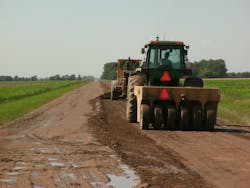Base stabilizer enhances properties of gravel roads in Minnesota
Polk County, Minn. has approximately 400 miles of gravel roads that it maintains.
“Every year the county would spend money adding gravel that was lost during the winter snowplowing season, have to fix frost boils, and receive complaints about muddy conditions during the rainy season,” said Richard Sanders, PE for Polk County Highway Dept. “Trying to maintain these gravel roads to the residents’ expectations was difficult in this highly agricultural area. The residents always have the opinion that they need their gravel roads paved. Polk County doesn’t receive enough money to pave and maintain every mile of gravel road.”
“To help correct this ongoing problem, we chose to use Team Laboratory Chemical Corp.’s BASE ONE base stabilizer to enhance the properties of our aggregate material. Our typical base stabilization project consists of prepping the road and because of the years of graveling, we consider each road to have 3 in. of gravel on it. We inspect the road and fix any soft subgrade areas, and then add new aggregate material and stabilize the top 4 in. of the roadway," Sanders stated.
“The contractor places all the gravel for the entire roadway being stabilized. They will then windrow one mile of gravel. The contractor pulls approximately 1.5 in. to 2 in. of material from the windrow,” continued Sanders. “The BASE ONE and water mixture is sprayed using the contractor’s water truck, and the application is inspected by county forces. The material is blade mixed with a motor grader and compacted with a pneumatic roller. This process is continued until the windrow is gone and the roadway is completed.”
“We were looking at ways to cut down on the blading and graveling of county roads and how we could most effectively maintain the roads we have,” Sanders said. “We knew that if we stabilized certain gravel roads within the motor grader’s district, they could maintain the remainder of their roads more effectively. We also knew that it would cut down on the amount of graveling needed in the future.”
“We have applied calcium chloride the year after stabilization to some, but not all of the roads. The years following the application rate of the chloride can be reduced, if not eliminated, based on residents in the area,” continued Sanders.
“Originally we were trying to make our gravel road blading more efficient by placing BASE ONE stabilized gravel on the roads toward the end of the blading routes, but since have added roads with large amounts of truck traffic.”
“Due to the success we have experienced stabilizing our gravel roads with BASE ONE, we have decided to start a five-year gravel stabilization program where we stabilize 20 miles of gravel a year. With this plan, we will also be including some of our troublesome gravel roads,” Sanders said.
“To date, we have 31 miles of BASE ONE stabilized roads. The end result is we have a stabilized gravel road that can handle typical agriculture traffic and one that the residents can appreciate,” Sanders concluded.
